Atkinson, George (McKechnie Section 2)
See also Section Six
Recorded by Jackson (The History of Silhouettes), who in that book confused later writers by attributing to Atkinson a large group of George III with his sons and sons-in-law which is now known to be by Atkinson's son, F. Atkinson (see Section One). This piece was at one time owned by Francis Wellesley, and was illustrated by Mills, whose illustration clearly shows the inscription, 'F. Atkinson, son of G. Atkinson, Profilist to the Royal Family of England.' This inscription has been consistently misread hitherto by writers who have reversed the relationship of father and son and consequently underestimated the importance of the father. In fact, much of the work previously ascribed to F. Atkinson was produced by his father.
On his trade labels George Atkinson usually refers to himself either as 'Mr. Atkinson' or simply 'Atkinson', and he nearly always mentions the work that he has done for the Royal family. Jackson records a 'portrait' of George III which was engraved by E. Scriven (1775-1841), a stipple engraver who worked for Boydell's Shakespeare Gallery (see Section One). It bears the inscription: 'From a drawing by George Atkinson, Profilist to His Majesty and the Royal Family, published 20th April, 1825.' I have not seen a copy of this print, but in the British Museum there is another print, also engraved by Scriven, of Frederick, Duke of York, which bears the words 'From the drawing by George Atkinson'(see Section Six).
1522
This is identical in shape (although the sitter faces the opposite way) to the figure of the Duke in George Crowhurst's full-length portrait of him with George IV (illustrated in this Section ).
730
It therefore seems more likely that the portrait mentioned by Jackson was of George IV, not of George III, and that it was on these two prints, probably well known in Brighton, that Crowhurst based his silhouette of the two royal subjects. On his Trade Label No. 3 Atkinson mentions that he took a profile of Queen Charlotte.
It has previously been stated that Atkinson lived in Windsor. The assumption probably derives from his constant references to his work for the Royal family, but there is no documentary evidence that he ever lived at Windsor or even that he took any of his royal portraits there. The earliest evidence of a place of work is to be seen on Trade Label No. 2, which refers to his work for 'Her Majesty, and H.R.H. the Prince Regent' and gives the brief address 'Strand', London. As Queen Charlotte died in 1818, and the Prince of Wales had become Regent in the early months of 1811, this label must have been in use in the Strand at some date between these years. No street number is given, and street directories have yielded no information. Atkinson cannot have owned a house in the Strand, but evidently rented a studio there.
The artist visited a number of seaside resorts, possibly during the summer while he was based on London. One label (No. 2) was printed in Portsea, although intended for use in London. Another (No. 3), printed in Teignmouth, was used in Dawlish, and also refers to a visit to Ramsgate and Margate during the previous summer. This label is difficult to date, for it has been seen on two profiles (both illustrated, one in Chapter Nine) painted in the manner of John Field, and the wording includes the sentence 'Old Profiles correctly copied'. These two examples may be copies of earlier work by Field.
253, 667
Much better documented is a stay in Brighton. Woodiwiss ('Heyday of the Brighton Profilists', Country Life, 8 November 1962) records an advertisement in the Brighton Ambulator in 1817; this includes these words: 'Atkinson, Profilist to H.R.H. Prince Regent, at Mr. Foster's, Linen Draper, next to the Blue Coach Office, Castle Square.' I think that Atkinson settled in Brighton for three or four years (although he may occasionally have visited London for a month or two in the winter). since a large proportion of labelled or inscribed profiles show a Brighton address. We know, however, from Trade Label No. 5 that during 1817 (either before or after he was based on Brighton) Atkinson worked for a time in Reading. In Baxter's Street Directory (Brighton) for 1822, George Atkinson is listed at 9 King's Road (possibly his dwelling), as well as at 40 Old Steine, an address, later used by Crowhurst, which is often seen on profiles taken by artists in Brighton. I have seen seven profiles of one family (in private possession), bearing an inscription, in a cursive hand, to the effect that they were taken by Atkinson, Profilist to the Royal Family, at 40 Old Steine. The entry in Baxter'sStreet Daleclat), would have been sent in in 1821; another, sent in in 1823, for the 1824 issue, gives only the address at 40 Old Steine. In the first of these directory references the artist is described as 'Profilist to His Majesty' (George IV); in the second, as 'Profilist to His Majesty and the Royal Family'.
The Illustrated silhouette of a woman of the Gresley family, from Derbyshire, suggests that at some time Atkinson ventured farther north, although it is possible that he took this silhouette in Brighton,which his sitter may have visited while on holiday.
674
As well as being a silhouette artist, Atkinson was a drawing master (stated on Trade Label No. 3), and the quality of his full-length portrait of the Duke ofYork, from which Scriven's print was made, suggests considerable artistic ability.
His work has not perhaps been valued at its proper worth, mainly because of the confusion with his far less gifted son.
Atkinson began his career by painting rather plain black profiles (without gum arabic), which he later referred to as 'now so very common' (Trade Label No. 4), I have seen a number of profiles of men of this period (1800-1810), but only one profile of a woman. The profiles of men are readily recognisable. The sitters wear the high stand-fall collar fashionable during this decade; the stock and shirt-frill are left white, a glimpse of hair is shown near the forehead outside the main body of the profile, and the bust-line finish, which is almost straight, is strengthened by a line running parallel to it beneath.
The only silhouette of a woman (Mrs Beal; illustrated) of this period that I know is in plain black, except that near the base the material of the dress is indicated by patches of muddy brown interspersed with blobs of black. There is no bust-line termination.
699
The two profiles, painted in gold against sepia, in the style of John Field, mentioned above, probably date from this period.
253, 667
Later bronzed profiles by Atkinson, more accomplished and individual in style, are painted in lavish gold against black. Considerable skill is shown in the use of thinned pigment; the sitter's ears are well painted in gold; and men's cravats and the details of women's dress are elegantly shown. Dead black is used only for the face, and for the strokes indicating depth of shadow on the clothing (where many other artists used gum arabic.) The brushwork is almost as skilful as that John Field. The bust-lines of profiles of men are similar to those of Atkinson's early work, but there is now no line below the base. Profiles of women are rather shallow (especially examples taken c. 1820). The sitters often wear the mancheron fashionable at the time, and the profiles are often terminated by the equally fashionable high waist-line of the dress, thus creating the effect of shallowness.
After 1820, Atkinson returned on occasion to the black silhouette. Two examples, both of women, are illustrated; they are painted in varying depths of black pigment, with highlights in Chinese white. Again, no gum arabic is used. Only the hair is painted in dead black, while the face is in dark grey. Ribbons on caps, and the fashionable 'vandyking', are all carefully picked out in white. The outlines of mancherons are carefully shown and the bust-line coincides with the waist-line of the dress.
671, 673
On the elegant late profile of a lady of the Gresley family, Atkinson introduces a little colour. The cap is painted in shades of pale bluish-grey, and a hint of green has been introduced into the transparency of the dress. The waist-line of the dress is still used as the bust-line, but in this case the height of the silhouette itself is increased because it was painted after 1824, during which year the waist-line of dresses fell to the natural level.
Dr D. S. Patton owns a typical profile of a man by Atkinson, painted in c. 1820 in lavish gold against black, but with the cravat painted in a delicate shade of turquoise blue.
Atkinson painted on rather thick paper. The sizes of his silhouettes vary considerably.
Examples taken in Brighton have been seen bearing advertisements of 'baths' owned by John Molineux of Brighton; two others which have been seen bore fragments of a poster which Atkinson no doubt exhibited outside his studio on the Steine.
Silhouettes painted before 1810 were normally housed in small oval frames of turned wood. Later silhouettes were framed in papier mâché; I have seen examples with a hanger showing the Prince of Wales' feathers, indicating the artist's Royal appointment to the Prince Regent.
Six trade labels are known. No. 1 is handwritten. Many examples have been seen; one (illustrated) is from the reverse of one of the illustrated profiles. No. 2, another handwritten label, reads 'Atkinson. Profilist to Her Majesty and the Royal Family'.
No. 3 (illustrated) is an elegant engraved label which, on account of the references to Her Majesty' and the Prince Regent, can only have been used 1811-18. The sentence at the top of this label reads, 'Profile Likenesses universally allowed to excel any yet offered to the Public.' In the rectangular shield the wording continues:
BY
Mr. ATKINSON
Bronze Profilist
To Her Majesty
His R.H. the Prince Regent
& Royal Family
Strand
LONDON
Terms from 5s. to 15s. and £1.1s.
Drawing Taught
Baker, Sculpt., Portsea
It is interesting that this label, intended for use in London, was engraved in Portsea.
An example of Trade Label No. 4 (illustrated) has survived, cut into two ovals, on the reverses of two profiles which almost certainly represent a father and his son. I give below the wording, illegible in some places and conjectural in others:
MODERN STYLE of executing PROFILE [?] LIKENESSES, sanctioned by the Royal family and the principle Nobility [?] of this Kingdom.
MR ATKINSON
BRONZE PROFILIST
From the Strand, at [illegible]
Respectfully informs the Inhabitants and Visitants of Teignmouth and Dawlish that he executes Bronze Profiles, in a style superlatively beautiful, which are admired and approved of by the principal Artists and Amateurs of this Kingdom and as they have become so very fashionable and preferable to those in Black (now so very common), the Public can never be presented with a better opportunity, even in the very minute size for Rings, Broaches, &c., &c.,
- Time of sitting less than One Minute.
Terms - Bronze Profiles from lOs 6d to 12s each, Colour'd ditto from 15s to 20s.
*Old Profiles correctly copied.
- At Ramsgate and Margate last summer, Mr. A. was honor'd with taking the Likenesses of upwards of 900 Persons, and as he is under the necessity of returning to London very shortly, he trusts those who wish to encourage him will immediately come forward.
Cro [illegible] [Teignm] outh.
No. 5 is a printed label; the only example which I have seen shows a date (1817) and an address
(Reading, and in larger letters, 'At Mr Pile's High Street).
No. 6 is a handwritten label which survives on the reverse of one of the illustrated silhouettes. It reads as follows:
ATKINSON, of Brighton and Windsor, No. 40, Old Steine, Brighton. The only Profilist His Majesty and the Royal Family have sat to. The sole inventor of the BRONZE PROFILES to her late Majesty and the Princesses. Frames of various patterns for mounting profiles, the cheapest in the Kingdom.
After his years in Brighton, Atkinson sometimes merely signed his silhouettes on the reverse.
Ills. 204, 253, 667-677
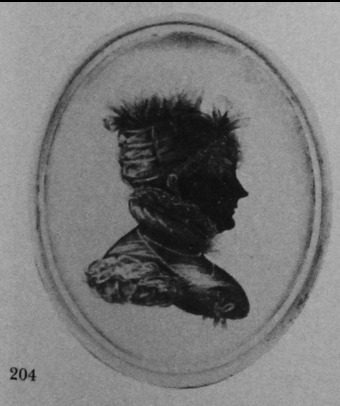
Unknown woman
Silhouette by George Atkinson, probably c. 1819.
costume dating points
The hair, with ‘peeping’ curls and probably a chignon at the top of the head, but not sufficient height to suggest the Apollo knot (in fashion after 1824).
The cap, possibly of the indoor variety, based on a turban style.
The long necklace, looped about, worn in the early 1820s.
The dress is probably a pelisse robe, first in fashion in c. 1819. The ribbons suggest that it fastened at the side.
The sleeve, headed by the popular mancheron.
Author’s collection
Chapter 9
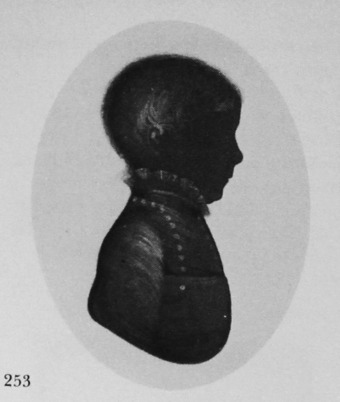
Unknown boy (aged about six).
Silhouette by George Atkinson, probably a copy of an original silhouette (c. 1812) by John Field.
costume dating points
The hair, short, but combed forwards on to the forehead.
The frill, narrow and high at the neck, apparently held in place by a ‘standing’ collar.
The skeleton suit, popular for boys of this age until c. 1830. Boys of this age wore the top of the suit inside the trousers.
Author’s collection
SECTION TWO
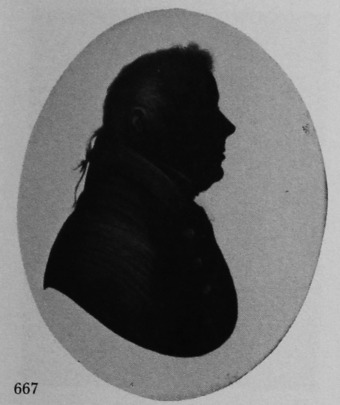
Unknown man
Silhouette painted on card in gold against a sepia background
c. 1804-1806
3¼ x 2¾in./83 x 70mm.
Trade Label No. 4
Frame: papier mâché
Taken at Dawlish, this silhouette may be a copy of an example by John Field.
Author’s collection
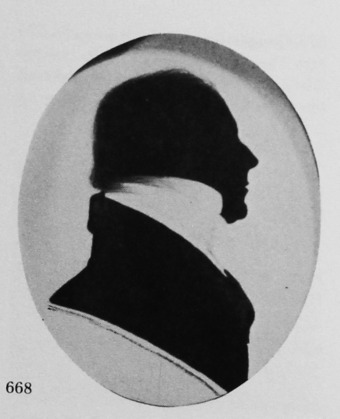
Mr. Beal
Silhouette painted on card
? c. 1806-1810
2½ x 2in./64 x 51mm.
Trade Label No. 1
Frame: oval, turned wood
Author’s collection
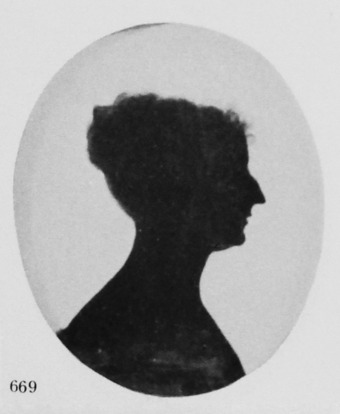
Mrs Beal, née E. Chantry
Silhouette painted on card, with base colour in brown
? c. 1806-1810
2½ x 2in./64 x 51mm.
Trade Label No. 1
Frame: oval, turned wood
The brown base is presumably intended to show the fabric of the sitter’s dress.
Author’s collection
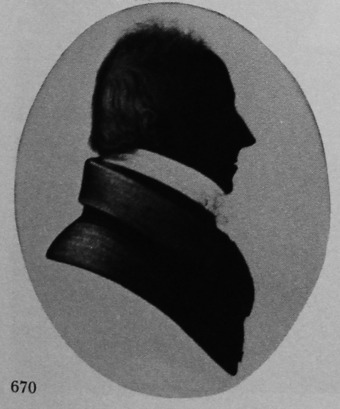
Unknown man
Silhouette painted on card, in gold against a black background
c. 1819
3 x 2½in./77 x 64mm.
Trade Label No. 3
Frame: papier mâché
Taken in London. The sitter’s wife is shown in 204.
Author’s collection
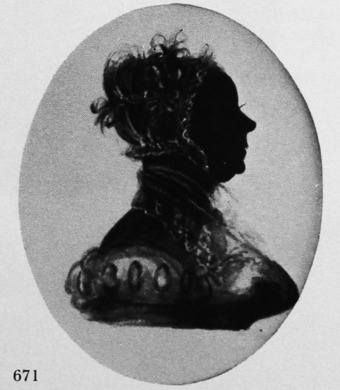
Unknown woman
Silhouette painted on car, in shades of black with Chinese white c. 1820-22
3 3/8 x 2½in./86 x 64mm.
Taken in Brighton.
Author’s collection
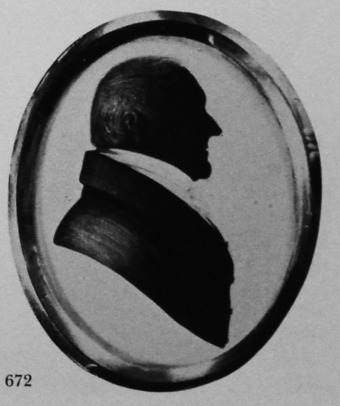
Unknown man
Silhouette painted on card, in gold against a black background
? c. 1822
3 1/8 x 2½in./80 x 64mm.
Frame: papier mâché, with leaf and acorn ring
Taken in Brighton.
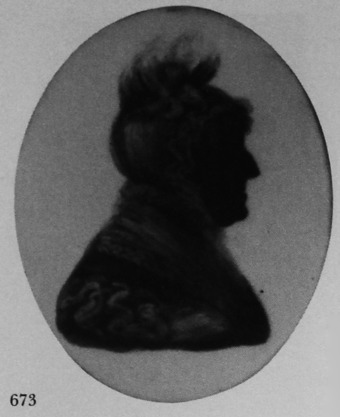
Mrs Tarté
Silhouette painted on card in shades of black, with detail in Chinese white
c. 1822
3 x 2½in./77 x 64mm.
Trade Label No. 6
Frame: papier mâché, with ‘emblems’ hanger
Taken in Brighton.
From the collection of the late J. C. Woodiwiss
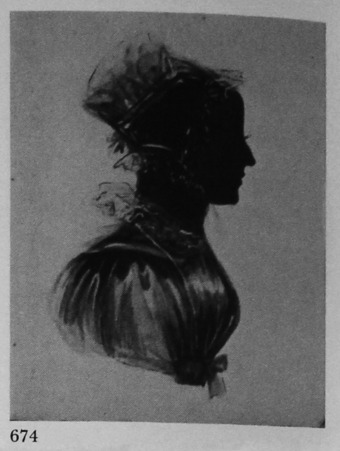
Unknown woman, a member of the Gresley family
Silhouette painted on card, with details in green, bluish-grey and gold
c. 1826
3¼ x 2¾in./83 x 70mm.
Signed on the reverse. The sitter’s family lived at Drakelow, Derbyshire.
Her grown is rendered in a greenish tint, her cap and pèlerine in pale bluish-grey. Her hair is touched with gold.
From the collection of the late J. C. Woodiwiss
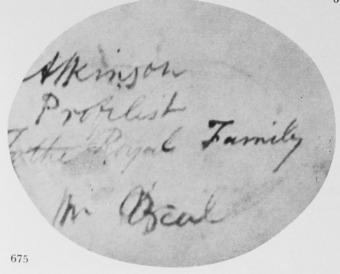
Trade Label No. 1 of George Atkinson.
Author’s collection
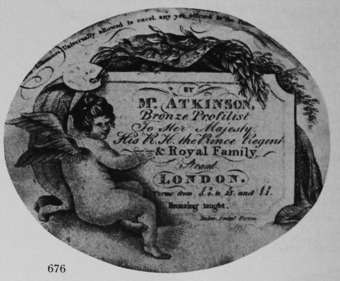
Trade Label No. 3 of George Atkinson.
Author’s collection
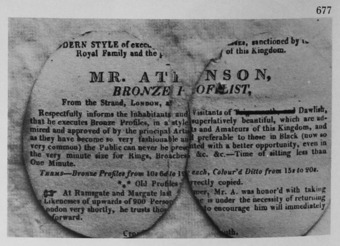
Trade Label No. 4 of George Atkinson.
Author’s collection
